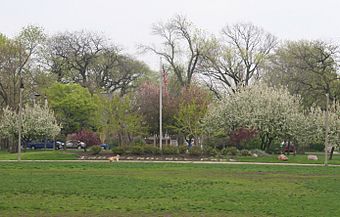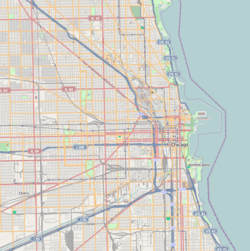Independence Park (Chicago) facts for kids
Quick facts for kids |
|
|
Independence Park
|
|
 |
|
| Location | 3945 N. Springfield Ave., Chicago, Illinois |
|---|---|
| Area | 7.16 acres (2.90 ha) |
| Architect | Hatzfeld & Knox |
| Architectural style | Late 19th And 20th Century Revivals |
| MPS | Chicago Park District MPS |
| NRHP reference No. | 09000023 |
| Added to NRHP | February 18, 2009 |
Independence Park is a fun place to play and relax in the Irving Park neighborhood of Chicago, Illinois. It's officially known as Park #83 by the Chicago Park District. This park is about 7 acres big. It first opened in 1914, but people in Irving Park have celebrated Fourth of July here since 1903!
Contents
Park History: How It Started
The Early Days of Irving Park
The Irving Park neighborhood started growing in the 1870s. This happened after a train line, the Chicago and North Western Railroad, connected the area. In 1889, Irving Park became part of Chicago. Around the year 1900, the neighborhood grew very quickly. Many local groups formed to help the people living there. These groups included the Irving Park Improvement Club and the Irving Park Women's Club.
Celebrating the Fourth of July
In 1903, these community groups worked together. They planned a big Fourth of July celebration. It took place in an open field near Irving Park Boulevard and North Springfield Avenue. The celebration included a parade and a reading of the Declaration of Independence. People also sang songs and played sports. In 1907, fireworks became a part of the fun!
Creating the Park District
In March 1910, people in Irving Park asked the Mayor of Chicago, Fred A. Busse, for their own park district. The mayor sent their request to a special park group. This group suggested that Irving Park should indeed form its own district.
So, on April 12, 1910, the Irving Park District was officially created. Five people were chosen to lead it. In August 1911, the new park district bought the land where the Fourth of July celebrations happened. They also bought land next to it, making a total of 5 acres.
Building the Field House
In 1913, the district hired architects Clarence Hatzfield and Arthur Howell Knox. Their job was to design a special building called a field house. These architects had worked for Dwight H. Perkins, who designed schools in Chicago.
Irving Park was a neighborhood with many middle and upper-class families. They wanted the park to feel like a country club. So, the field house was designed with cool features. It had an indoor swimming pool, a ballroom for dancing, and a gymnasium for sports. When the building opened, the Women's Club moved their library to the second floor. Independence Park was officially opened on the Fourth of July, 1914. The building also served as the main office for the park district.
Fun Activities at the Park
In its early years, the park had many things to do. There was a running track, baseball fields, and a playground. It also had a wading pool for kids and two shelters. In winter, the baseball fields were flooded to create ice skating rinks! The park hosted high school sports in 1918. An ice skating competition was held there in 1920.
The library grew too big for the field house in 1928. It moved to its own building at 3715 W. Irving Park Road. By the late 1920s, the park also had horseshoe courts, putting greens for golf, and tennis courts.
Park Expands and Changes
In 1929, the park district bought more land, making the park 7.86 acres big. They bought nine houses, but eight of them were taken down. One house, a bungalow, was kept and became the Women's Club House. This bungalow was built in 1920 for a businessman named John Luttrell Coppersmith.
In 1930, the large baseball field was removed. It was replaced with a beautiful sunken garden. This was because it cost too much to light and keep up the field during the Great Depression. The garden had a lily pool, a flagpole, and the park's name spelled out in concrete.
The Great Depression also caused changes for the park district. In 1934, the Irving Park District joined with 22 other park districts in Chicago. This created the larger Chicago Park District. Money from the Works Progress Administration helped the park. They restored a softball field, the tennis courts, and the horseshoe courts. Funds also helped turn the bungalow's basement into an arts and crafts studio. In 1937, an artist named Max Decker painted a mural for the gymnasium.
In 1949, a new large baseball field was added to the park.
Independence Park Today
Today, Independence Park has many modern features. There's a new playground and a spray pool for hot days. It also has parking lots and a shelter for people waiting for the CTA bus. You can see decorative fences, two planters with flowers, and a dolphin sculpture. There's also a special rock dedicated to Charles A. Karavitch.
The park is very important for its history. On February 18, 2009, it was added to the National Register of Historic Places. This means it's recognized as a special place in history by the National Park Service.


